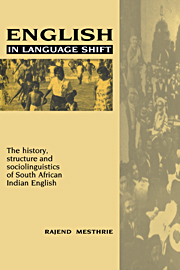 English in Language Shift
English in Language Shift Book contents
- Frontmatter
- Contents
- List of figures and maps
- List of tables
- Preface
- Acknowledgements
- List of abbreviations
- 1 Historical background: the shaping of a New English
- 2 Variation in SAIE: a first glimpse
- 3 Syntactic variation: the relative clause
- 4 Word-order principles
- 5 Non-syntactic variation
- 6 Perspectives from second-language acquisition
- 7 Perspectives from pidgin and creole studies
- Appendix A Comparison between SAIE sample and census data for Indians in Natal
- Appendix B Types of relative clauses used by individual speakers
- Appendix C Rank orders for relative clauses, topics and morphology
- Notes
- Sources and references
- Index
1 - Historical background: the shaping of a New English
Published online by Cambridge University Press: 03 December 2009
- Frontmatter
- Contents
- List of figures and maps
- List of tables
- Preface
- Acknowledgements
- List of abbreviations
- 1 Historical background: the shaping of a New English
- 2 Variation in SAIE: a first glimpse
- 3 Syntactic variation: the relative clause
- 4 Word-order principles
- 5 Non-syntactic variation
- 6 Perspectives from second-language acquisition
- 7 Perspectives from pidgin and creole studies
- Appendix A Comparison between SAIE sample and census data for Indians in Natal
- Appendix B Types of relative clauses used by individual speakers
- Appendix C Rank orders for relative clauses, topics and morphology
- Notes
- Sources and references
- Index
Summary
Introduction
South African Indian English (henceforth SAIE) spoken by about three-quarters of a million people, chiefly in the province of Natal, offers the linguist and sociologist an opportunity of examining the dynamics of language shift. This study will first focus on the means by which English has become established as the first language of this speech community, ousting in the process several ‘ancestral’ Indian languages. It is my chief aim, however, to examine the kind of variation that arises in such a situation, and the type of language acquisition involved. At the same time I will describe the more interesting features of the dialect and compare them with second-language varieties of English and (similar) former second languages turned first language.
‘New’ Englishes
English as a dominant world language assumes a variety of forms in various parts of the globe, so much so that it has been for some time now problematic to speak of the English language. Sociologically speaking, it might make greater sense to think in terms of an ‘English language family’ – a cover term for a number of varieties with very different histories, functions and structural characteristics. As Kachru (1988) has indicated, many of the ‘sacred cows’ of English are untenable in the latter half of the twentieth century. It is now the property of the world at large, with the number of interactions in English amongst non-native speakers probably exceeding that amongst mother-tongue speakers, and between mother-tongue speakers and non-mother-tongue speakers.
- Type
- Chapter
- Information
- English in Language ShiftThe History, Structure and Sociolinguistics of South African Indian English, pp. 1 - 33Publisher: Cambridge University PressPrint publication year: 1993


